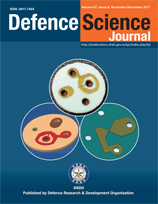Fabrication and Evaluation of Low Density Glass-Epoxy Composites for Microwave Absorption Applications
DOI:
https://doi.org/10.14429/dsj.67.11331Keywords:
Light weight composites, Mechanical properties, Fracture morphology, electromagnetic properties, Radar absorbing structures, RASAbstract
In the present work, fabrication and evaluation of low density glass – epoxy (LDGE) composites suitable for absorbing minimum 80 per cent of incident microwave energy in 8 GHz to 12 GHz (X-band) is reported. LDGE composites having different densities were fabricated using a novel method of partially replacing conventional S-glass fabric with low density glass (LDG) layers as the reinforcement materials. Flexural strength, inter laminar shear strength and impact strength of the prepared LDGE composites were evaluated and compared with conventional High density glass-epoxy (HDGE) composites to understand the changes in these properties due to replacement of S-glass fabrics with LDG layers. To convert LDGE structures to radar absorbing structures controlled quantities of milled carbon fibers were impregnated as these conducting milled carbon fibers can act as dielectric lossy materials which could absorb the incident microwave energy by interfacial polarisation. Electromagnetic properties namely loss tangent and reflection loss of carbon fiber impregnated LDGE composites were evaluated in 8 GHz -12 GHz frequency region and compared with HDGE composites. It was observed that both LDGE and HDGE composites have shown loss tangent values more than 1.1 and minimum 80 per cent absorption of incident microwave energy. Thus the results indicates that, LDGE composites can show EM properties on par with HDGE composites. Furthermore these LDGE composite could successfully withstand the low velocity impacts (4.5 m/s) with 50 J incident energy. Due to their ability to show good mechanical properties and light weight, LDGE composites can be used as a replacement for conventional HDGE composites to realise radar absorbing structures.
Downloads
Published
How to Cite
Issue
Section
License
 Where otherwise noted, the Articles on this site are licensed under Creative Commons License: CC Attribution-Noncommercial-No Derivative Works 2.5 India
Where otherwise noted, the Articles on this site are licensed under Creative Commons License: CC Attribution-Noncommercial-No Derivative Works 2.5 India


